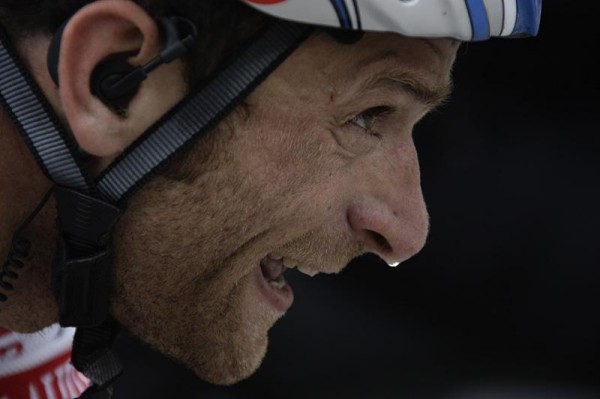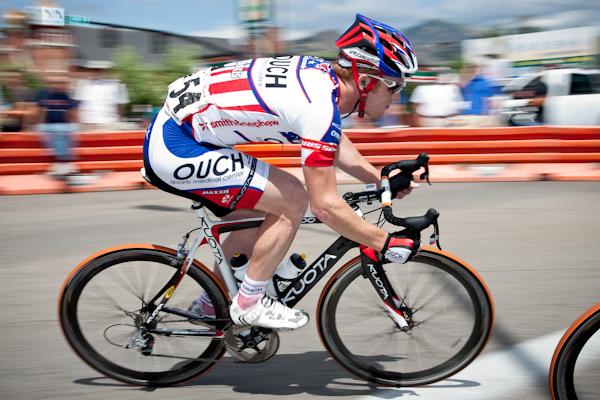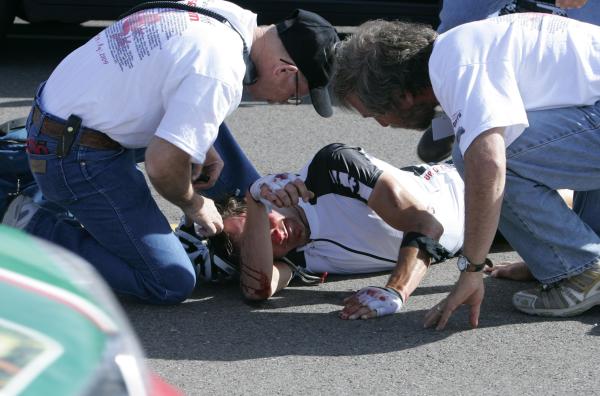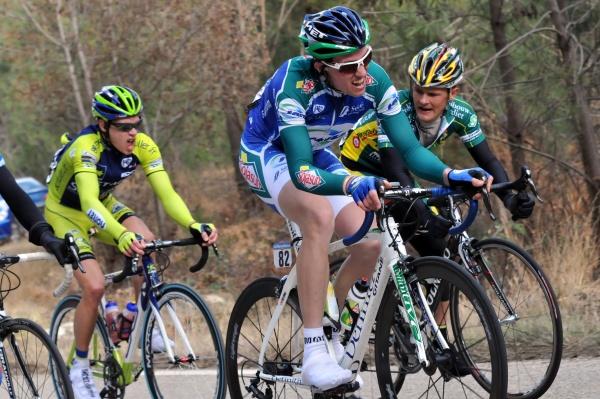Cyclingnews Fitness Q&A - February 10, 2010
Your fitness questions answered




Got a question for the fitness panel? Send it to fitness@cyclingnews.com. Emails may be edited for length or clarity, but we try to publish both questions and answers in their entirety.
Adjusting training to lower heart rate
I am a 45-year-old Cat 5 father of four. I just competed in a Masters 35+ cat 4/5 criterium which is the first race of the 2010 season. It was 40 minutes over a one-mile loop with a small elevation gain. The hill was just long enough to saturate my legs with lactic acid once I reached the top.
I thought my winter training had been the best in years because I achieved my "race ready benchmark" earlier than ever; keeping up with a large, fast weekly group ride that includes state champs and continental pro riders which goes about 50 miles. Over the course of that weekly ride my average heart rate has been 160-168 bpm with my maximum rate of 191 twice in that 50 miles.
Therefore I was a little dissapointed to see that my average heart rate for the race was 182 bpm. Not a comfortable place to be for 40 minutes. Nine beats per minute to spare does not leave a lot of reserve for attacking or sprinting. In addition to the long weekend ride I put in two days (30 miles) a week during lunch and one night a week (40 minutes) on the trainer doing descending intervals to try and raise my lactate threshold level.
What adjustments do I need to make? Start racing 45+? Carry oxygen?
Thanks,
Jeff
Scott Saifer says
Get The Leadout Newsletter
The latest race content, interviews, features, reviews and expert buying guides, direct to your inbox!
Jeff,
There's something funny going on here. Was the cat 5 race really harder than riding with continental pros? If it was, it sounds like you're not riding particularly efficiently, or else your pro buddies are noodling on that ride you kept up on.
On to actually answering your question: The trick to lowering heart rate for any given effort and raising lactate threshold power is to do longer rides at strictly aerobic intensity. To start you might set your heart rate zone to 70-80 percent of maximum heart rate (133-153 bpm for you) for all but one ride each week. It's the upper limit that really matters.
And just so you know, intervals done near LT decrease or maintain LT power, but improve your tolerance for that effort. Riding below LT pushes it up.
Head injuries from cycling crashes
During the past year, I've noticed more reports about professional cyclists suffering head injuries both in and out of competition. The most recent being Matthias Kessler's resulting from a training accident and Scott Nydam's possible career-ending injury in last year's Tour of the Gila.
Until the middle of this past decade, however, head injuries seemed to be less common. I'm fully aware that prior to this time they did occur (Andrei Kivilev's tragic death being the most memorable) and probably more injuries occurred than those reported. Is it just the result of more reporting of these injuries? Or, is there a significant difference between the number of injuries before and after the date the UCI required riders to wear helmets at its events (I'm thinking it was a year after Kivilev's death)?
Assuming the number of injuries actually increased with the requirement of helmets, what would be the reason? Is it that the riders believe the helmet is able to protect their heads despite the force of the impact? Also, would a rider's skill in protecting themselves during a crash come into play?
Kevin
Albuquerque, NM, USA
Scott Saifer says
Kevin,
I can't answer the question of the head injury frequency before and after the helmet rule, but I can confirm for you that there is solid research on risk taking behavior with perceived safety equipment in place. When car manufacturers add air bags or better seat belts to their products, the injury rates don't fall as much as you'd expect based on the actual benefit of the safety devices.
People really do drive more dangerously if they feel cocooned in their cars. It would not be surprising to me to learn that helmets have a similar effect on bike riders.
That being said, you also should recognise that the rate of head injuries in UCI races is so low that it may not be possible to do a good statistical comparison of before and after. There are not enough injuries, and there are too many confounding factors: better brakes, wetter and dryer racing years, different tires and so on all affect the number of crashes and injuries.
Pedal stroke angle
What is the proper leg opening angle while at the bottom of the pedal stroke typically? I am fexible enough to almost get my palms on the floor while doing a hamstring stretch, but I am trying to determine if my saddle is too high.
Karsten Walker
Scott Saifer says
Karsten,
Steve can give you more precise guidance, but the short answer is that while most riders will fall in particular range of angles for each joint when set up for optimal power and comfort, there are outliers.
There is no one angle that will be correct for all riders, nor is there one angle that is "best" that we should try to reach if we are flexible enough. Your seat is too high if you have any sense of stretching for the bottom of the pedal stroke, or rocking to be able to reach it.
What I see when doing a fit if a saddle is too high is usually a pause in the flexion-extension of the knee combined with a sudden acceleration in the extension of the ankle near the bottom of the stroke. In other words, the ankle movement loses its smoothness. Riding in that position eventually causes hamstring injuries and/or saddle contact soreness.
If you think your seat is too high because it feels too high, it probably is.
Can't reach max heart rate
Hi,
I just did a max test this evening and could only get to 183 beats per minute, when about a year ago I managed to get to 197. My power output was slightly better than last time, but I felt crap and think I could have done a whole lot better. My HR even went down towards the end of the test.
I have just had a recovery week (seven days) after a hard training camp totalling 40 hours in 10 days, but I didn't nail myself. The two reasons I could think of were tiredness and illness, but I don't feel sick and I just came off a whole seven days of recovery. Any thoughts?
Sandy
Scott Saifer says
Sandy,
You haven't given us enough information to give a definitive answer, but there are plenty of benign reasons that you might not be able to get to the same max heart rate as a year ago, as well as one nasty one. The heart rate dropping near the end of a max test is called "peaking over". It's expected and a sign that you got a true maximum value.
1) If you were new to endurance training a year ago, you should expect to lose 6-10 beats off your maximum heart rate as you train in your first year. That loss should stabilize after the initial 6-10 beat drop. I've seen numerous riders lose 6-10 beats and a few lose more. Your 14 beat drop would be a lot, but not huge.
2) Test done in warm conditions can limit maximum heart rate. You didn't say if the conditions were similar on the two tests, but if it was a few degrees warmed for this test than the last one and you didn't have a fan blowing on you, that could explain the difference.
3) You could well be fatigued from your camp. A week is not long enough to fully recover from a really hard 10 days. You say you didn't completely bury yourself so I doubt this would explain a 14 beat drop, but it might explain a few beats.
4) You haven't said anything about your regular training and resting routine: overtraining will bump down maximum heart rate.
5) Heart disease can cause a rapid and continuing slide in maximum heart rate with no symptoms other than the limitation of maximum heart rate until you've lost many beats. I've seen a rider continue racing until he'd lost 50 beats, though always wondering why he wasn't as fast as he used to be.
If you're a lot more fit than last year, which would be consistent with your higher speed, don't worry about the loss of maximum heart rate beats unless it continues. If you are not a lot more fit than last year, retest in a few weeks somewhere that you are sure you won't be getting hot. If you continue losing more beats, consult your cardiologist.
Maintaining optimum performance
I always seem to struggle after the first day of multi-day events, and was wondering if you would be able to help me understand what is going on.
While not an event, this weekend was a good example of what happens:
- Saturday I did a solid 140km ride with quite a few hills (I am training for the 3 Peaks Challenge in March). I tried to set a good pace up all of the hills while keeping my heart rate to around 150bpm, while if I am racing up the hills I will be sitting on mid 160s to low 170s. After the ride I had a lunch with a mixture of protein and carbs, along with quite a few fluids over the remainder of the day.
- On Sunday my legs felt tired, but not too bad, but when I tried to climb the same type of hills I was barely able to get my heart rate over 130bpm, and my speed was 3-4 km/h lower than usual.
I am a 49 year old male, who has been riding reasonably competitively for quite a few years. I don't do a large number of multi-day events, but when I have I have usually noticed that my performance has dropped off more on the second day than most others, i.e. people I was able to stay with on day one am able to easily beat me on day two.
Any ideas on what is going on?
David
Sydney, NSW
Scott Saifer says
David,
There's no one obvious answer based on what you've told us so far, so I'll just list some possibilities.
Are you getting enough carbs during the first day's ride? You should be getting somewhere between 250-325 calories per hour of ride, divided into 3-4 chunks. The more you can absorb (not just choke down but actually absorb), the less depleted you are at the end of the ride.
Once you are glycogen depleted, it take about three days to recharge, so eating enough to get to the end of the ride but just barely leaves you at a disadvantage for the next day.
Are you getting enough carbs in the hours after the first ride? You mentioned a post-ride meal, but you also need to trickle in carbs the rest of the afternoon after a 140 km ride. You can store about 1000 Calorie of carbs, plus your body continues to use carbs as fuel the rest of the day, which means you need to eat at least a bit more than 1000 carbohydrate calories over the rest of the day.
Are you staying hydrated on the first day's ride? Once you are more than little dehydrated, it takes several days to restore electrolytes to the appropriate concentrations across all compartments of your body. If your urine is very pale and comes within the first half hour or so after a ride, or you pee several times during the ride, you are drinking enough.
If you don't pee during the ride and your first post-ride pee is more than a half hour post-ride and it is dark in colour, you are not drinking enough on the ride and that would be costing you the next day.
Are you getting enough salt to make up for sweat losses? Are you wearing sunscreen on the first day's ride, generously applied and is the sun is strong? "Solar toxicosis" will leave you deeply fatigued.
Are you choosing gears appropriately on the first day? If your buddies are spinning while you mash bigger gears, you are accumulating more fatigue than they are, like doing a weight lifting rather than endurance workout.
Did you relax and get off your feet quickly after the first ride? If your buddies are napping while you do yard work or build fences or something, they're going to be much stronger than yo the second day.
Do you get plenty of high quality sleep between the two rides? Sleep needs vary between individuals, but somewhere around nine hours would be typical for good recovery from a long ride.
If you are doing everything right (getting plenty of food, salt and water during and after the first ride, relaxing after, getting plenty of sleep and using appropriate gears) and you still don't do okay the second day, these is a chance that you have a medical issue that is preventing recovery and should consider a visit to the doctor, but less than optimal behavior on any of those issues could explain your whole problem. Good luck sleuthing out the cause and fixing it.
David then responded:
Scott,
Thanks for the response. Most of these areas I feel comfortable with, but there are certainly a couple of points I will concentrate on:
1. I am eating one energy bar (around 200 calories) per hour for the first couple of hours, and then I also include a gel (around 100 calories) every half hour.
2. While I don't particularly calculate the calories it provides I am fairly happy with the typical post ride meal that I have - usually something like some ham, cheese, tomato and whole grain bread. However I do need to ensure that I have appropriate carbs for the remainder of the day as I tend to start eating a bit of junk calories later in the day.
3/4. Hydration is an area that it sounds like I need to watch as while I did pee once during the ride, my first post-ride pee was a good half hour after the ride, and was quite dark. I went through three bottles of sports drink, plus one bottle of water (three litres total) during the ride on what was a warm, but not hot day (around 25C max).
I might try going to a hydration pack for the long rides as they do make it easier to drink consistently.
5. Definitely a yes on the sunscreen, I never go out without it.
6. Generally I felt happy with the gears I was using, with the majority of the ride just using the small chain ring.
7/8. I didn't do anything too much for the remainder of the day, and then had a reasonable 8 hours sleep - which is about the most I ever sleep.
I will try to increase the amount of fluids that I take in, but if this doesn't work do you have any suggestions on what I can get a doctor to look at, as I'm not really sure what to ask for.
The Cyclingnews Form & Fitness panel
Steve Hogg (www.cyclefitcentre.com) has owned and operated Pedal Pushers since 1986, a cycle shop specialising in rider positioning and custom bicycles. In that time he has positioned riders from all cycling disciplines and of all levels of ability with every concievable cycling problem. Clients range from recreational riders and riders with disabilities to World and National champions.
Scott Saifer (www.wenzelcoaching.com) is head coach, CEO of Wenzel Coaching.com and has been coaching cyclists professionally for 18 years. He combines a master's degree in Exercise Physiology with experience in 20 years of touring and racing and over 300 road, track and MTB races to deliver training plans and advice that are both rigorously scientific and compatible with the real world of bike racing.
Scott has helped clients to turn pro as well as to win medals at US Masters National and World Championship events. He has worked with hundreds of beginning riders and racers and particularly enjoys working with the special or challenging rider. Scott is co-author of Bike Racing 101 with Kendra Wenzel and his monthly column appears in ROAD Magazine.
Kelby Bethards, MD received a Bachelor of Science in Electrical Engineering from Iowa State University (1994) before obtaining an M.D. from the University of Iowa College of Medicine in 2000. Has been a racing cyclist 'on and off' for 20 years, and when time allows, he races Cat 3 and 35+. He is a team physician for two local Ft Collins, CO, teams, and currently works Family Practice in multiple settings: rural, urgent care, inpatient and the like.
Pam Hinton has a bachelor's degree in Molecular Biology and a doctoral degree in Nutritional Sciences, both from the University of Wisconsin-Madison.
She did postdoctoral training at Cornell University and is now an associate professor of Nutrition and Exercise Physiology at the University of Missouri-Columbia where she studies the effects of energy balance on bone health. She has published on the effects of cycling and multi-day stage racing on bone density and turnover.
Pam was an All-American in track while at the UW. She started cycling competitively in 2003 and is a three-time Missouri State Road Champion.
David Fleckenstein, MPT, OCS (www.physiopt.com) is a physical therapist practicing in Eagle, ID and the president of Physiotherapy, PA, an outpatient orthopedic clinic focusing in orthopedics, spine, and sportsmedicine care.
His clients have included World and US champions, Olympic athletes and numerous professional athletes. He received his Masters degree in Physical Therapy from Emory University and is currently completing his doctorate at Regis University.
He is a board certified orthopedic specialist focusing in manual medicine and specific retraining of spine and joint stabilisation musculature. He is a former Cat I road racer and Expert mountain biker.
Carrie Cheadle, MA (www.carriecheadle.com) is a Sports Psychology consultant who has dedicated her career to helping athletes of all ages and abilities perform to their potential. Carrie specialises in working with cyclists, in disciplines ranging from track racing to mountain biking. She holds a bachelors degree in Psychology from Sonoma State University as well as a masters degree in Sport Psychology from John F. Kennedy University.
Dave Palese (www.davepalese.com) is a USA Cycling licensed coach and masters' class road racer with 16 years' race experience. He coaches racers and riders of all abilities from his home in southern Maine, USA, where he lives with his wife Sheryl, daughter Molly, and two cats, Miranda and Mu-Mu.
Dario Fredrick (www.wholeathlete.com) is an exercise physiologist and head coach for Whole Athlete™. He is a former category 1 & semi-pro MTB racer. Dario holds a masters degree in exercise science and a bachelors in sport psychology.